Yield sign
In road transport, a yield or give way sign indicates that merging drivers must prepare to stop if necessary to let a driver on another approach proceed. A driver who stops or slows down to let another vehicle through has yielded the right of way to that vehicle. In contrast, a stop sign requires each driver to stop completely before proceeding, whether or not other traffic is present. Particular regulations regarding appearance, installation, and compliance with the signs vary by some jurisdiction.
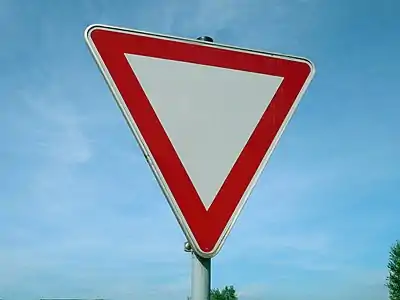
Terminology
While give way and yield essentially have the same meaning in this context, many countries have a clear preference of one term over the other. The following table lists which countries and territories use which term. This chart is based on official government usage in the English language and excludes indirect translations from other languages.
History
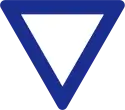
A black triangle (within the standard down-arrow-shape of stop signs) was a symbol of "stop for all vehicles" from about 1925 in Germany. The triangular yield sign was used as early as 1938 when it was codified in Czechoslovakia in a blue-white variant without words[1] and in 1939 in the Protectorate of Bohemia and Moravia which adopted the current red-white variant.[2] In the United States, the first yield sign was erected in 1950 in Tulsa, Oklahoma, designed by Tulsa police officer Clinton Riggs;[3] [4][5] Riggs invented only the sign, not the rule, which was already in place.[6] Riggs' original design was shaped like a keystone; later versions bore the shape of an inverted equilateral triangle in common use today.
Country specifics
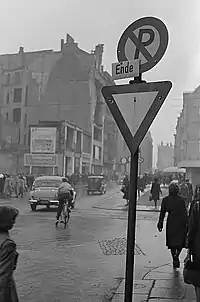
Australia
In Australia, the Give Way sign evolved similarly to its counterpart in the United States. During the 1940s and 1950s, the sign was circular and yellow. In 1964, the sign changed to a red triangle. In the 1980s, the sign adopted its modern design and gained a counterpart for use at roundabouts.
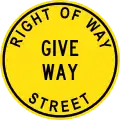 Original design (1940-1964)
Original design (1940-1964).svg.png.webp) Second version (1964-1974)
Second version (1964-1974) Modern design since 1974
Modern design since 1974
Ireland
In road signs in Ireland, the yield sign reads yield in most areas, although in Gaeltacht (Irish-speaking) areas the text is géill slí ("yield way"[7]) instead.[8][9] Signs erected between 1962 and 1997 read yield right of way,[10] which remains legally permitted.[9] Signs 1956–62 had a blank white interior.[11]
.svg.png.webp) Previous design (1961–97)
Previous design (1961–97).svg.png.webp) Modern design in English (1997–present)
Modern design in English (1997–present).svg.png.webp) Modern design in Irish (1961–present)
Modern design in Irish (1961–present)
New Zealand
In New Zealand, the original design also used the keystone shape as in the United States but used a black background with a red border. In the 1980s, the modern design was adopted. On sealed roads, the give way sign is always accompanied by a white line painted on the road to clarify the rule to road users even if the sign is obscured or missing.[12]
.svg.png.webp) Original design (1975-1987)
Original design (1975-1987) Modern design since 1987
Modern design since 1987
United Kingdom


The United Kingdom's Road Traffic Act calls for give way signs and road markings at junctions (crossroads) where the give-way rule is to apply. The road marking accompanying the sign consists of a large inverted triangle painted just before the place to give way, which is marked by broken white lines across the road.[13]
In Wales, some signs bear a bilingual legend: the Welsh ildiwch appears above give way.
In the United Kingdom, a stop or give-way sign may be preceded by an inverted, blank, triangular sign with an advisory placard such as give way 100 yards.[14]
United States
In the Federal Highway Administration's Manual on Uniform Traffic Control Devices, a yield sign may be warranted[15]
"if engineering judgment indicates that one or more of the following conditions exist:
- When the ability to see all potentially conflicting traffic is sufficient to allow a road user traveling at the posted speed, the 85th-percentile speed, or the statutory speed to pass through the intersection or to stop in a reasonably safe manner.
- If controlling a merge-type movement on the entering roadway where acceleration geometry and/or sight distance is not adequate for merging traffic operation.
- The second crossroad of a divided highway, where the median width at the intersection is 9 m (30 ft) or greater. In this case, a STOP sign may be installed at the entrance to the first roadway of a divided highway, and a YIELD sign may be installed at the entrance to the second roadway.
- An intersection where a special problem exists and where engineering judgment indicates the problem to be susceptible to correction by the use of the YIELD sign."
The sign went through several changes from its original design to the sign used today. Originally invented in 1952 and added to the MUTCD in 1954, the sign used the "keystone" shape before adopting the more readily recognized triangular shape. In 1971, the sign evolved into its modern version and changed from yellow to red, paralleling the same change that had earlier been made by Stop signs.
.svg.png.webp) Early design (1950-1954)
Early design (1950-1954).svg.png.webp) Second version (1954-1961)
Second version (1954-1961).svg.png.webp) Third version (1961-1971)
Third version (1961-1971)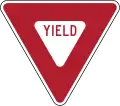 Modern design as agreed to in 1971
Modern design as agreed to in 1971
Gallery
 International standard with white background (most countries around the world use this version)
International standard with white background (most countries around the world use this version)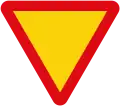
 SACU standard (Botswana, Eswatini, Lesotho, Namibia, South Africa) (no longer used, the blue background has since been phased out in favour of white)
SACU standard (Botswana, Eswatini, Lesotho, Namibia, South Africa) (no longer used, the blue background has since been phased out in favour of white)
Signs with text in English
 Antigua and Barbuda, Australia, Bahamas, Barbados, Bhutan, Dominica, Ethiopia, Ghana, Grenada, India, Isle of Man, Jamaica, Kenya, Malta, Mauritius, Montserrat, Pakistan, Papua New Guinea, Philippines, Saint Kitts and Nevis, Saint Lucia, Seychelles, Singapore, Tanzania, Tonga, Trinidad and Tobago, Uganda, United Kingdom, Vanuatu
Antigua and Barbuda, Australia, Bahamas, Barbados, Bhutan, Dominica, Ethiopia, Ghana, Grenada, India, Isle of Man, Jamaica, Kenya, Malta, Mauritius, Montserrat, Pakistan, Papua New Guinea, Philippines, Saint Kitts and Nevis, Saint Lucia, Seychelles, Singapore, Tanzania, Tonga, Trinidad and Tobago, Uganda, United Kingdom, Vanuatu
.svg.png.webp)



Signs with text in Spanish
Signs with text in other languages
See also
References
- Government ordinance No. 100/1938 Sb. n. a z., Czechoslovakia
- Government ordinance No. č. 242/1939 Sb. (Protectorate of Bohemia and Moravia)
- Curtis, Gene (February 6, 2007), TPD Blog: Tulsa cop invented the 'yield' sign, retrieved 2009-04-05
- Curtis, Gene (6 February 2007), "Tulsa cop invented the 'yield' sign: ONLY IN OKLAHOMA.", Tulsa World, Tulsa, OK, retrieved 2009-04-05
- Fales, Edward D, Jr (September 9, 1956), "NewspaperARCHIVE.com - Search old newspaper articles online", Oakland Tribune, retrieved 2009-04-05
- "A Brief History of Yield Signs". Road Traffic Signs. Retrieved 2012-06-26.
- Ó Dónaill, Niall. "slí". Foclóir Gaeilge–Béarla. Retrieved 7 June 2016.; Ó Dónaill, Niall. "géill". Foclóir Gaeilge–Béarla. Retrieved 7 June 2016.
- "Regulatory Traffic Signs". Rules of the Road. Ireland: Road Safety Authority. 2014. Retrieved 7 June 2016.
- "S.I. No. 181/1997 - Road Traffic (Signs) Regulations, 1997". Irish Statute Book. Section 8 (1); and Fourth Schedule, note 4. Retrieved 7 June 2016.
- Department of Local Government. "S.I. No. 171/1962 - Road Traffic (Signs) Regulations, 1962" (PDF). Official Publications. Pr.6772. Dublin: Stationery Office. pp. 7 (Section 5) and 27 (First Schedule, Part III, Section A). Retrieved 7 June 2016.
- Department of Local Government. "S.I. No. 284/1956 - Traffic Signs Regulations, 1956" (PDF). Official Publications. Pr.3844. Dublin: Stationery Office. pp. 9 (Section 5) and 35 (First Schedule, Part III, Section A). Retrieved 7 June 2016.
- "Give way road markings and signs".
- Road Markings, www.direct.gov.uk, p. 3, retrieved 2009-04-04
- Warning signs, www.direct.gov.uk, p. 1, retrieved 2009-04-04
- FHWA - MUTCD - 2003 Edition Revision 1 Chapter 2B
- http://www.fr.brezhoneg.bzh/evenement/1506/50-actualite.htm
















.svg.png.webp)